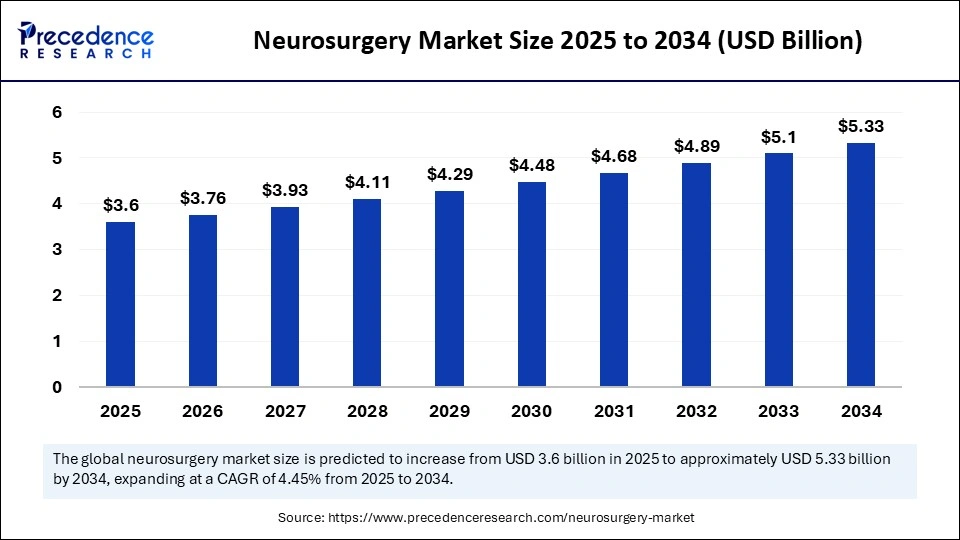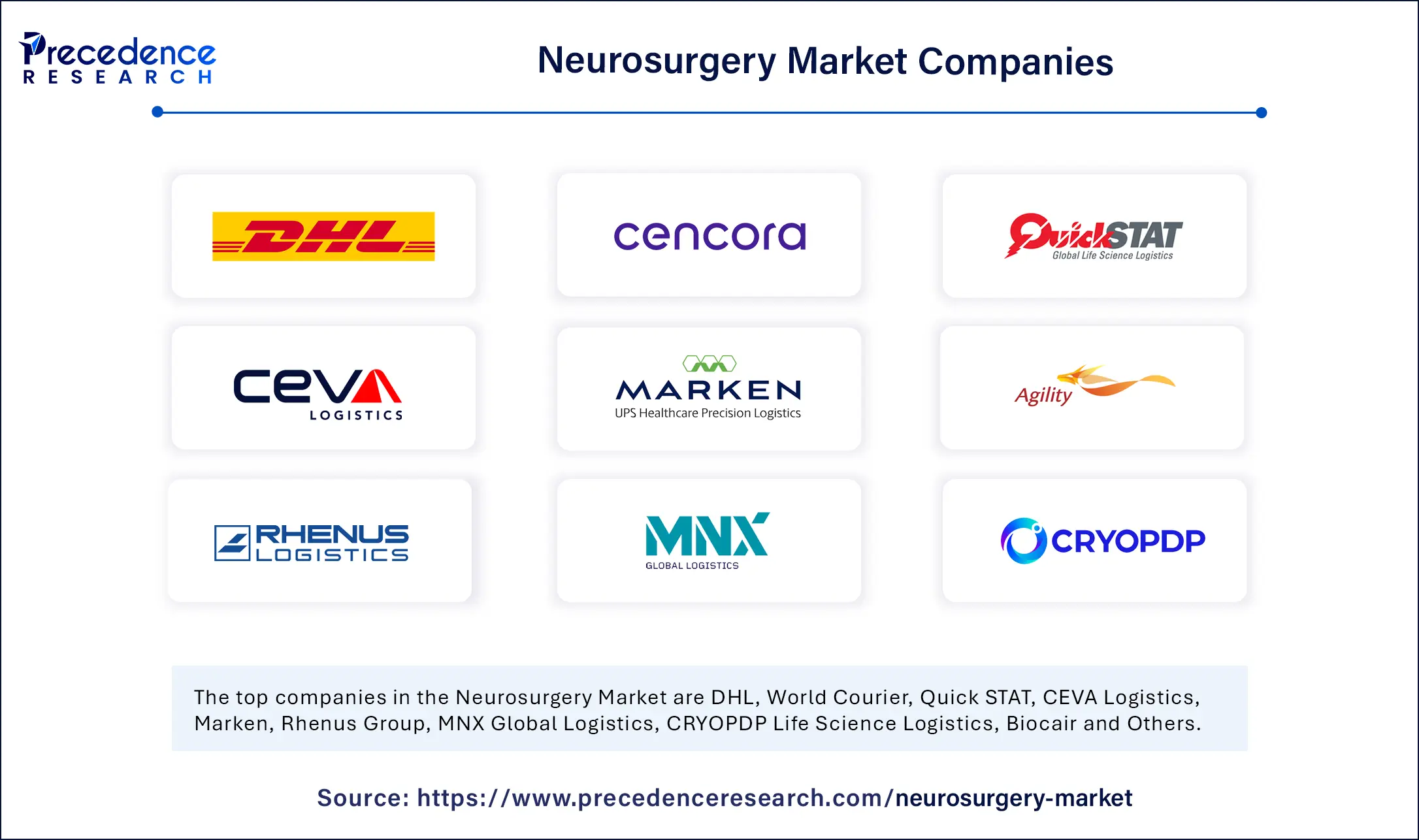
Neurosurgery Market Key Points
-
In 2024, North America dominated the neurosurgery market, accounting for the highest share of 57%.
-
Asia Pacific is expected to witness the fastest growth rate between 2025 and 2034.
-
Among product types, the neuroendoscopes segment held the largest share of the market in 2024.
-
The radiosurgery systems segment is projected to grow at a notable CAGR throughout the forecast period.
-
By indication type, the brain cancer segment led the market with the highest share in 2024.
-
The traumatic brain injuries segment is anticipated to expand at the fastest CAGR over the projected timeline.
-
Hospitals and specialty clinics emerged as the leading end-users in 2024, contributing the largest market share.
-
Ambulatory surgical centers are expected to register the highest growth rate during the forecast period.
Neurosurgery Market Overview
The neurosurgery market is a critical segment of the broader surgical and medical device industry, primarily focused on the diagnosis, treatment, and rehabilitation of disorders affecting the brain, spinal cord, and nervous system. This market includes a wide range of products and services such as neurostimulation devices, neurosurgical instruments, stereotactic systems, surgical microscopes, and neuronavigation tools. The increasing global prevalence of neurological disorders like epilepsy, Parkinson’s disease, brain tumors, and traumatic brain injuries has significantly driven demand for neurosurgical interventions.
Moreover, the aging population, particularly in developed countries, is increasingly susceptible to neurological conditions, further boosting the market. With the rising adoption of minimally invasive surgical techniques, and rapid advancements in imaging technologies and robotic systems, the neurosurgery market is expected to experience substantial growth. Hospitals, specialty clinics, and ambulatory surgical centers are investing heavily in modern neurosurgical equipment to enhance precision, safety, and patient outcomes.
Neurosurgery Market Growth Factors
Multiple factors are fueling the growth of the neurosurgery market. One of the most important is the rising incidence of neurological disorders and injuries globally. Stroke, Alzheimer’s disease, and spinal cord injuries are becoming more prevalent due to lifestyle changes, urbanization, and increased life expectancy. Additionally, increased awareness and diagnosis of such disorders are prompting more patients to seek early and specialized surgical intervention.
Another major growth factor is the advancement in surgical technologies, such as the development of high-resolution intraoperative imaging, 3D visualization, and robotic-assisted surgeries, which enable greater precision and minimize complications. Furthermore, the expansion of healthcare infrastructure in emerging economies is providing new avenues for growth, as more neurosurgery centers and trained professionals become available. Government initiatives, insurance coverage expansion, and public-private partnerships are also driving investment in neurosurgical care.
Impact of AI on the Market
Artificial intelligence (AI) is significantly reshaping the neurosurgery market by improving diagnostics, surgical planning, and intraoperative decision-making. AI-powered tools are being used to analyze complex imaging data, such as MRIs and CT scans, with greater accuracy and speed than traditional methods. This allows for earlier detection of tumors, aneurysms, and degenerative brain diseases, which in turn leads to more effective treatment planning.
Intraoperatively, AI is enhancing robotic neurosurgery platforms, allowing real-time adjustments and improving the precision of surgical interventions, particularly in delicate areas like the brainstem or spinal cord. Additionally, machine learning algorithms can predict patient-specific surgical risks and post-operative complications, enabling personalized care plans.
AI also plays a critical role in neuro-navigation, helping surgeons track instruments in real time and avoid critical structures, thus reducing surgical errors. Moreover, AI is accelerating research into brain-computer interfaces (BCIs) and neuromodulation therapies, which are paving the way for innovative treatments in paralysis and neurodegenerative disorders. Overall, the integration of AI is not only improving clinical outcomes but also optimizing operational efficiency in neurosurgical departments, marking a transformative shift in how neurological conditions are treated.
Market Scope
| Report Coverage | Details |
| Market Size by 2034 | USD 5.33 Billion |
| Market Size in 2025 | USD 3.6 Billion |
| Market Size in 2024 | USD 3.45 Billion |
| Market Growth Rate from 2025 to 2034 | CAGR of 4.45% |
| Dominating Region | North America |
| Fastest Growing Region | Asia Pacific |
| Base Year | 2024 |
| Forecast Period | 2025 to 2034 |
| Segments Covered | Product Type, Indication Type, End User, and Region |
| Regions Covered | North America, Europe, Asia-Pacific, Latin America, and Middle East & Africa |
Market Drivers
The neurosurgery market is being driven by several important trends and clinical demands. A key driver is the increasing adoption of minimally invasive neurosurgical procedures, which offer quicker recovery times, reduced hospital stays, and lower complication rates. Technologies like endoscopes, image-guided surgery, and high-definition cameras are making these procedures more accessible and reliable.
Another strong driver is the growing demand for neuromodulation devices such as deep brain stimulators and spinal cord stimulators, especially for patients suffering from chronic pain, Parkinson’s disease, and epilepsy. The rise of robot-assisted neurosurgery is also a major catalyst, improving surgical accuracy and expanding the types of procedures that can be performed. Additionally, an increased focus on improving healthcare quality and patient outcomes is prompting hospitals to upgrade neurosurgical capabilities and invest in advanced instrumentation and systems.
Opportunities
The neurosurgery market presents promising opportunities for innovation and expansion. One of the most compelling is the development of next-generation robotic neurosurgical platforms with enhanced AI integration and haptic feedback, enabling surgeons to perform complex procedures with greater control and fewer complications. Additionally, there is an emerging opportunity in personalized neurosurgery, where genomic and biomarker data are used to tailor treatments for brain tumors or neurodegenerative conditions. Another major opportunity lies in the expansion of neurosurgical services in low- and middle-income countries, where access has historically been limited. With growing investments in medical tourism, healthcare infrastructure, and professional training, many of these regions are poised to become important markets.
The use of virtual reality (VR) and augmented reality (AR) in neurosurgical training and planning is also gaining traction, offering immersive environments for simulation and reducing the learning curve for new surgeons. Furthermore, advancements in wearable neuro-monitoring technologies and tele-neurosurgery may provide greater continuity of care, especially in rural or remote locations. Companies that can offer cost-effective, portable, and user-friendly solutions are likely to capitalize on these growing needs.
Challenges
Despite robust growth, the neurosurgery market faces several challenges. High equipment costs and installation complexity remain major barriers, especially for hospitals in developing regions. Advanced neurosurgical systems require substantial investment in not only equipment but also specialized training and support infrastructure. Additionally, there is a global shortage of trained neurosurgeons, which limits the number of procedures that can be performed, particularly in underserved regions. Another pressing issue is surgical risk and complexity, as neurosurgical procedures involve critical areas of the brain and spine, where even minor errors can result in significant morbidity or mortality.
Regulatory hurdles also pose a challenge, as new neurosurgical devices and techniques must undergo extensive clinical trials and approval processes to ensure safety and efficacy. Data privacy and security concerns, particularly with AI and connected devices, are becoming more pronounced as digital solutions grow in popularity. Lastly, reimbursement variability and healthcare access disparities can limit patient uptake of innovative treatments, particularly in regions with underdeveloped healthcare systems.
Regional Outlook
Geographically, North America holds the largest share of the neurosurgery market, driven by a high prevalence of neurological disorders, well-developed healthcare systems, strong adoption of advanced medical technologies, and significant R&D investments. The presence of leading medical device manufacturers and academic institutions further supports regional innovation. Europe also represents a mature and technologically advanced market, with increasing adoption of robotic and AI-driven neurosurgical systems, supported by favorable reimbursement policies and public health funding.
The Asia Pacific region is expected to witness the highest growth during the forecast period from 2025 to 2034, driven by improving healthcare infrastructure, expanding medical tourism, rising health awareness, and a growing middle class. Countries like China, India, and South Korea are making significant investments in neurosurgical equipment and training, creating robust demand. Latin America and the Middle East & Africa are gradually emerging markets, with growth fueled by urbanization, improved diagnostic capabilities, and support from global health organizations. However, these regions still face challenges related to cost, training, and healthcare accessibility.
Neurosurgery Market Companies

- DHL
- World Courier
- Quick STAT
- CEVA Logistics
- Marken
- Agility
- Rhenus Group
- MNX Global Logistics
- CRYOPDP
- Langham Logistics
- Life Science Logistics
- Biocair
- Others
Segments Covered in the Report
By Product Type
- Neuroendoscopes
- Neurosurgical Drills
- Radiosurgery Systems
- Dura Substitutes
- Neurological Ablation Device
- Neurosurgery Instruments
By Indication Type
- Brain Cancer
- Craniofacial Trauma
- Spine and Skull Base Tumors
- Traumatic Brain Injuries
- Craniofacial Trauma
- Parkinson’s Disease
- Tourette’s Syndrome
- Others (Craniosynostosis, etc.)
By End-User
- Hospital and Specialty Clinics
- Ambulatory Surgical Centers
- Others (Academics and Specialized Neurological Institutes, etc.)
By Region
- North America
- Europe
- Asia-Pacific
- Latin America
- Middle East and Africa
Also Read: Malaysia Plasma Fractionation Market
Get this report to explore global market size, share, CAGR, and trends, featuring detailed segmental analysis and an insightful competitive landscape overview @ https://www.precedenceresearch.com/sample/6245
You can place an order or ask any questions, please feel free to contact at sales@precedenceresearch.com|+1 804 441 9344
- Arteriovenous Implants Market Enhance dialysis outcomes with advanced grafts, endovascular access, and AI-assisted precision - September 16, 2025
- Smart Retinal Implants Market Restore vision with wireless bioelectronic prosthetics and AI-powered retinal technologies - September 16, 2025
- Myopia Treatment Devices Market Size to Reach USD 38.51 Billion by 2034, Growing at a CAGR of 7.86% - September 1, 2025
